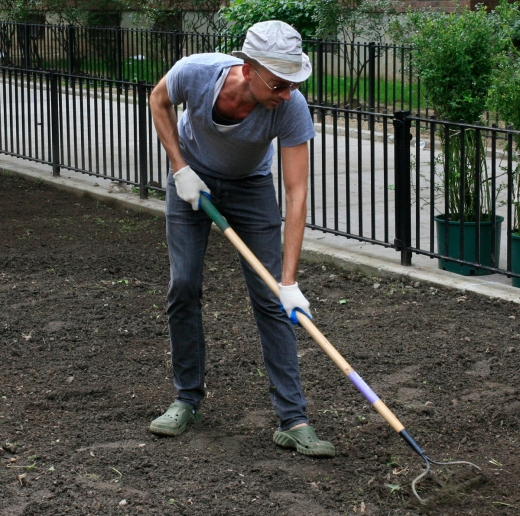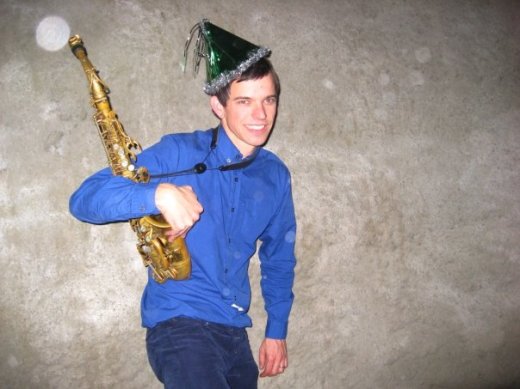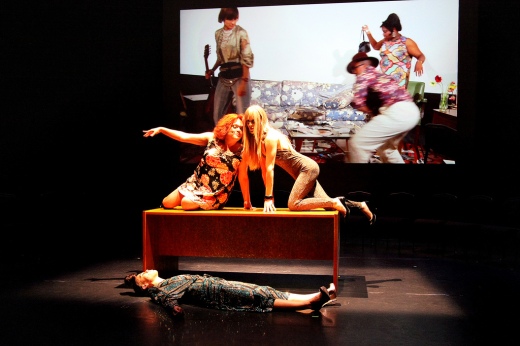
Fritz Haeg working on the "Lenape Edible Estate: Manhattan" produced and presented by New York Restoration Project in partnership with Friends of the High Line, 2009.
1. Do you now or have you ever considered yourself a performance artist?
Sure! Plus anything else people might want to call me.
If so, when did you begin to identify yourself as a performance artist?
When I read it in the newspaper.
2. What was the first performance art you ever encountered in your life? How did you respond?
Probably in school? I recall a project involving all of us licking candy off the body of a classmate during a group critique. Developing an interest in architecture at a young age, my curiosities began to expand beyond the confines of that discipline by the time I reached my early 20’s. All of my friends were artists, actors, and performers, those were the people that I wanted to be with. I mostly took art classes during my last year of college in which some friends were experimenting with performative work. I would also go to the drama department’s student plays. I was especially envious of the “dramats.” When I had a flash of inspiration in my architecture work, it might take hours, days, weeks or months to express it. Even then it would only be in the form of drawings and models, representations of the ideas, never fully realized as actual experience. In the professional practice of architecture this process can take years, and when it is received by an audience you are not even there. Those dramats, on the other hand, could have a complete complex thought, act it out, and immediately receive a live response – all in an instant. There was something so alive and immediate about it that I was missing at my drafting table. Architecture is slow, which can make it a satisfying pursuit to age into through a lifetime, but it can also make it very removed from the moment. I suppose this is what I was missing most.
3. Do you make distinctions between performance art and other forms of performance?
I am not interested in pure forms. I am interested in the opposite of purity. Regarding the topic at hand: Can gardening be both architecture and performance? Can a casual and conversational lecture be a performance with out being performative? What is it called when we put on our warm-up clothes and get ready to move together as a group?
4. What makes a performance successful, in your opinion?
The most ambitious approach, the ultimate path of freedom, the essential truth of our moment, and the only direction worth pursuing, is to begin each endeavor with the assumption that it is ultimately doomed to fail. Then we ask ourselves “how amazing, ecstatic, alive, and revelatory was our failure?”

"Animal Drills" from Animal Estates 1.0: New York" commissioned by the Whitney Museum of American Art for the 2008 Whitney Biennial - as performed by Felicia Ballos (Wood Duck), Layla Childs (Big Brown Bat), Anna Sperber (Mason Bee), Levi Gonzales (Northern Flying Squirrel), Paige Gratland (beaver), Michael Helland (Bobcat), Jmy Leary (Eastern Tiger Salamander), Daniel Linehan (Opossum), Alex Escalante (Purple Martin), and Kayvon Pourazar (Barn Owl) on March 22nd, 2008.
5. Who is your ideal audience, or, rather, how do you construct your public?
If I am making a garden, the neighbors on the street might play the role of the impromptu, unsuspecting audience. If I am organizing a workshop or conversation there is no audience, just curious and dedicated participants. If I am making an urban animal home, the wildlife I may never see or interact with will be a very active audience. If I am giving a talk, the audience is very clearly defined, somewhat passive, and typically self- selecting. If I am making a book, the audience might have a very solitary and intimate experience with the work. If I am making a website, the audience could be fleeting, distracted, lost, confused, or very focused, and maybe just seeking certain information. If I am making a video, the audience might be together for a social experience in a public screening, or alone at their computer. If I am making a parade, those in the parade might be an audience for the people that have come to watch them.
6. Have you found support in the art world, or other worlds, for the development and presentation of your work?
Yes, no, and sort of, but all of my best opportunities were those that I created for myself.
7. What did you study in school?
Architecture.
Did you have mentors?
Yes, but I never met most of them, and if I did, I received much more from their example than from any personal conversations we may have had. Ant Farm (Chip Lord), Mel Chin, Buckminster Fuller, Anna Halprin, Mierle Laderman Ukeles, Gordon Matta-Clark, Helio Oticica, Yvonne Rainer, Andy Warhol, Meg Webster, and Andrea Zittel are those that immediately come to mind.
8. Who/what inspires your most recent body of work?
Fresh home-made local food and the daily routine of stretching, warming up, exercise, and especially the accompanying work-out clothes: stretchy, tight, comfortable, flowing, baggy, loose, casual, ready to move…that is all I want to wear.
9. How important is your body to your work?
It is becoming more important and interesting the older I get. I never exercised or thought about what I ate when I was younger. Now I’m vegan and my daily schedule is built around yoga class and swimming. They are very personal decisions about my own body, but also political and extremely social as soon as I step out my door. It’s about health, but for me it has more to do with pleasure, and of course it is inextricably related to my recent work with public food production and group movement.
What do you want the viewer to feel/think in relation to that body?
To begin to remember that they have one too.
10. Have you been encouraged by recent developments in public discourse around performance art?
Yes!
Discouraged?
Yes!
What is the worst development in recent years?
As everything accelerates, so does the rush to judge and evaluate. You could argue that the conventional forms of painting and sculpture are slow, and performance is fast, amplifying the urgency for quick judgment and dismissal.
11. What does your family think about your work?
When I moved to New York City from an Italian farmhouse in 1994, instead of returning to the sort of architecture office day jobs I had since high school, my father tried to convince me to get a day job as a waiter, and make art at night. A few months ago he asked me with a puzzled and concerned look on his face, “so, are you a performance artist now?”
12. Is performance art a medium, like painting?
It depends on whether you want to curate it, sell it, organize it, study it, pursue it, understand it, or participate in it….

Clarence and Rudine Ridgely in front of their house and "Edible Estate #6: Baltimore, Maryland" commissioned by the Contemporary Museum Baltimore, 2008.
Video: Sundown Schooolhouse: Practicing Moving – Day #19
Visit fritzhaeg.com.














